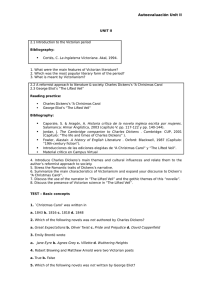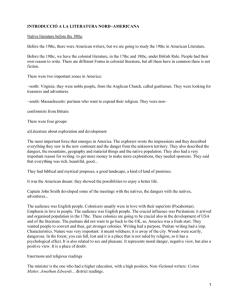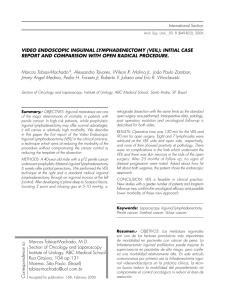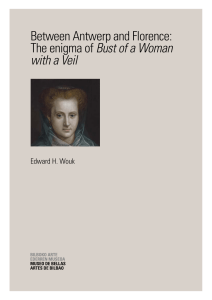Nathaniel Hawthorne
Anuncio
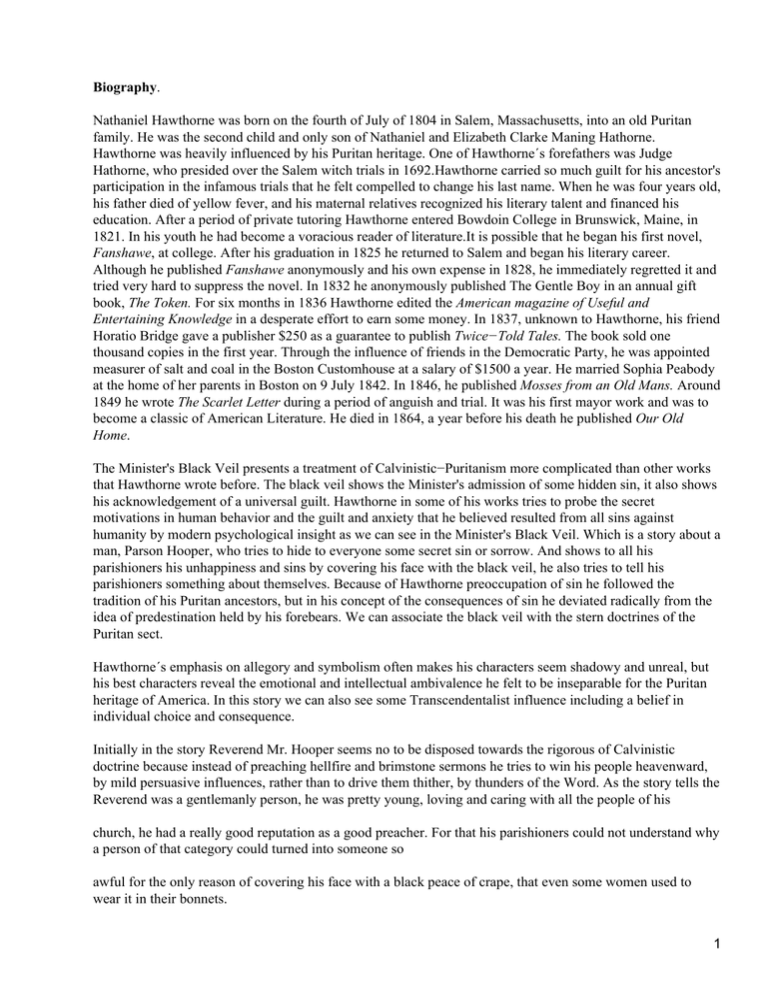
Biography. Nathaniel Hawthorne was born on the fourth of July of 1804 in Salem, Massachusetts, into an old Puritan family. He was the second child and only son of Nathaniel and Elizabeth Clarke Maning Hathorne. Hawthorne was heavily influenced by his Puritan heritage. One of Hawthorne´s forefathers was Judge Hathorne, who presided over the Salem witch trials in 1692.Hawthorne carried so much guilt for his ancestor's participation in the infamous trials that he felt compelled to change his last name. When he was four years old, his father died of yellow fever, and his maternal relatives recognized his literary talent and financed his education. After a period of private tutoring Hawthorne entered Bowdoin College in Brunswick, Maine, in 1821. In his youth he had become a voracious reader of literature.It is possible that he began his first novel, Fanshawe, at college. After his graduation in 1825 he returned to Salem and began his literary career. Although he published Fanshawe anonymously and his own expense in 1828, he immediately regretted it and tried very hard to suppress the novel. In 1832 he anonymously published The Gentle Boy in an annual gift book, The Token. For six months in 1836 Hawthorne edited the American magazine of Useful and Entertaining Knowledge in a desperate effort to earn some money. In 1837, unknown to Hawthorne, his friend Horatio Bridge gave a publisher $250 as a guarantee to publish Twice−Told Tales. The book sold one thousand copies in the first year. Through the influence of friends in the Democratic Party, he was appointed measurer of salt and coal in the Boston Customhouse at a salary of $1500 a year. He married Sophia Peabody at the home of her parents in Boston on 9 July 1842. In 1846, he published Mosses from an Old Mans. Around 1849 he wrote The Scarlet Letter during a period of anguish and trial. It was his first mayor work and was to become a classic of American Literature. He died in 1864, a year before his death he published Our Old Home. The Minister's Black Veil presents a treatment of Calvinistic−Puritanism more complicated than other works that Hawthorne wrote before. The black veil shows the Minister's admission of some hidden sin, it also shows his acknowledgement of a universal guilt. Hawthorne in some of his works tries to probe the secret motivations in human behavior and the guilt and anxiety that he believed resulted from all sins against humanity by modern psychological insight as we can see in the Minister's Black Veil. Which is a story about a man, Parson Hooper, who tries to hide to everyone some secret sin or sorrow. And shows to all his parishioners his unhappiness and sins by covering his face with the black veil, he also tries to tell his parishioners something about themselves. Because of Hawthorne preoccupation of sin he followed the tradition of his Puritan ancestors, but in his concept of the consequences of sin he deviated radically from the idea of predestination held by his forebears. We can associate the black veil with the stern doctrines of the Puritan sect. Hawthorne´s emphasis on allegory and symbolism often makes his characters seem shadowy and unreal, but his best characters reveal the emotional and intellectual ambivalence he felt to be inseparable for the Puritan heritage of America. In this story we can also see some Transcendentalist influence including a belief in individual choice and consequence. Initially in the story Reverend Mr. Hooper seems no to be disposed towards the rigorous of Calvinistic doctrine because instead of preaching hellfire and brimstone sermons he tries to win his people heavenward, by mild persuasive influences, rather than to drive them thither, by thunders of the Word. As the story tells the Reverend was a gentlemanly person, he was pretty young, loving and caring with all the people of his church, he had a really good reputation as a good preacher. For that his parishioners could not understand why a person of that category could turned into someone so awful for the only reason of covering his face with a black peace of crape, that even some women used to wear it in their bonnets. 1 When the Reverend Hooper entered the church the first time with the black veil on his face the parishioners thought was not him but his sermon was the same as always so they knew that it was in fact their Minister. The sermon was the same but it had something peculiar, something that was hurting their souls and frightening them, they were more frightened by the black veil than by the sermon. In the sermon he explained what were the secret sins and those sad mysteries that a lot of people tried to hide, so he tried to teach them something about themselves. In Hawthorne´s words Reverend Mr. Hooper was a very efficient clergyman. Active sinners flock to him and dying sinners call him to their deathbeds. Part of the story takes place during the years 1730−41 when Jonathan Belcher was governor of Massachusetts and New Hampshire. These were the years that witnessed the last great revival of Calvinistic doctrine in America, the years of the Great Awakening during which preachers like Jonathan Edwards thundered the Doctrine of the Elect from the pulpits of New England churches, and waves of religious enthusiasm spread throughout the colonies. Aided by the shocking appearance of the black veil in his face the Reverend Mr. Hooper has so profound an effect on his congregation that even the laws of the colony reflected that gloom. In the story Mr. Hooper preached the election sermon of Governor Belcher, and the black veil made such big impression upon everybody that the legislative measures of that year were known for everybody by all the gloom and piety of their ancestral influence. In The Minister´s Black Veil, as well as in other Hawthorne´s works we can see the influence of spiritual and moral issues from a uniquely American standpoint, and also political influences in his topics. Other personal influences reflected in Hawthorne´s writing include his love of reading and nature. In this story the moral influences are very well represented because of what Reverend Hooper tried to do by not removing the veil, even when he was dying or when he knew that he was going to lose his wife and he was going to be unhappy, was to teach his parishioners to deal with their sins. He was trying to teach them to confront their sins and sorrows even if it meant being unhappy for the rest of their lives. He did not care that everyone in the village talked about him or stared at him whenever he went to any place or when he was just walking on the streets. He knew that he was doing what he thought was right and he held with the consequences. Hawthorne´s literary style was so highly stylized and romanticized that sometimes received a strong criticism. Still he was hailed as an insightful writer, who was able to craft novels resolving around such sensitive topics as adultery because of his established reputation as an important author of his time. Parson Hooper at the end of the story, although if in the beginning everybody thought that he was crazy, in the end everybody admired and loved him and could not believe how a man of such characteristics could existed. Because he was a man devoted to his church, he gave up everything because of the veil which was suppose to be a good reason, even when he was at the doors of death he did not let anybody take out the black veil. Everybody thought that he was keeping some secret sin inside which tortured his conscience so badly, they thought that he was going to reveal the secret that he was keeping since so many years before he died. When his wife asked him to remove his veil, Reverend Hooper tried to explain her that whenever he would be able to get rid of the sins and sorrows, which was killing him, he was going to take away the veil. And he also explained her that the veil was but a mortal veil and it was not for eternity. For Minister Hooper the black veil was just a symbol and he was bound to wear it until the sin cease. In the beginning he already knew that the veil was going to separate him from everything, he was really lonely and very frightened to be by himself inside of that veil, although he thought himself that he was something awful and he understood that everybody could be frightened of him. The veil made him a really efficient clergyman, by the aid of his emblem he started to have a really dangerous power in his hands over souls that were in 2 agony for sin. But it seems that he never removed the black veil off him, because he died with the veil on and he did not let Parson Mr. Clark removed it. After talking with his wife no attempts were made to convince parson Hooper to removed it, nobody else tried to find out about the secret of the veil. That mysterious symbol was never withdrawn from him, he notified at the beginning that non−one and nothing was ever going to withdraw the veil. So he died with his secret and nobody knew the real truth about the veil. He died being a great person who everybody admired and knew around the country, he turned to be for everyone Father Hooper which was the way that the people used to called him after his courage and faith. 3
